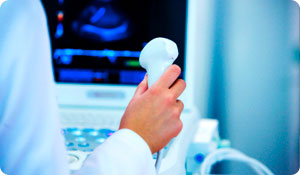
Historically, Crohn's disease, an inflammatory bowel disorder, has been difficult to diagnose. This is in part because its symptoms are similar to other bowel disorders, such as ulcerative colitis, which also cause abdominal cramping and diarrhea. However, the bigger problem has been that the small intestine is difficult to examine using conventional diagnostic methods. Now, several studies are showing that bowel ultrasound is more accurate than X-ray in identifying the complications, location and extent of Crohn's disease. Plus, bowel ultrasound may also be useful in detecting postoperative complications and long-term disease recurrence.
Unlike other radiologic tests-such as X-ray-that use radiation to see inside the body in the diagnosis of Crohn's disease, ultrasound (also called sonography) uses sound waves to examine the organs of the pelvis and abdomen without any exposure to radiation. Technological advancements of ultrasound equipment over the last few years have improved the image resolution so much, it's now possible to get accurate cross-sectional imaging of the intestinal wall, allowing physicians to pinpoint the extent of inflammation in the ileum (small intestine) or colon.
Tests Used to Diagnose Crohn's Disease
While bowel ultrasound is proving accurate in diagnosing and assessing the extent of Crohn's disease, there is still no one definitive diagnostic test for Crohn's disease. Instead, your gastroenterologist will use the information from a variety of tests to determine whether you have the disorder. First, your doctor will take your medical history and give you a physical examination. That information, coupled with the results of laboratory, endoscopic and imaging tests will provide a clear diagnosis.
Laboratory Tests
- A complete blood count test is done to look for signs of Crohn's disease, including the presence of anemia and elevated white blood cells, which may indicate the presence of inflammation
- A stool sample is also be taken to look for blood and infectious organisms
Endoscopy
- Sigmoidoscopy is used to examine the rectum and left (sigmoid) colon
- Colonoscopy gives a view of the entire colon and can reveal how extensive a certain area is inflamed. It's also used to rule out cancer concerns in patients who have had Crohn's disease for a long time
- Upper endoscopy is performed by placing an endoscope in the patient's mouth and guiding it to the upper intestine to spot ulceration and inflammation in the upper GI tract
Radiologic Tests
- Upper and lower gastrointestinal barium X-rays to look for abnormalities in the small intestine
- Computerized tomography (CT) scan to detect abnormalities in the liver, kidneys and intestine
- Magnetic resonance imaging (MRI) uses radio waves to detect fistulas and abscesses





